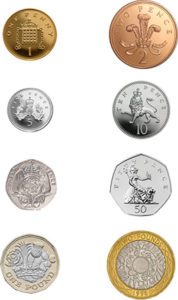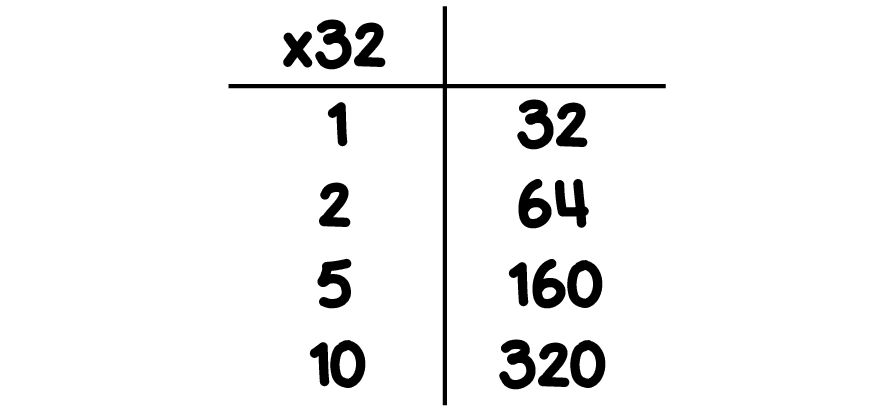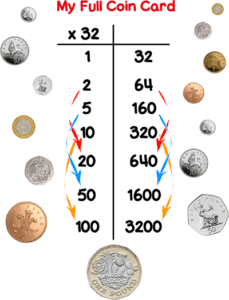Coin Multiplication
A big part of becoming confident with numbers is being able to quickly and easily find multiples—and to understand how and why the method works. It’s not just about getting the right answer, but about building a strong understanding of how numbers relate to each other.
With Big Maths, children are taught a simple, powerful method called Coin Multiplication. This helps them see patterns and make connections between numbers and operations. As they improve, they’ll learn how to work out trickier multiples by building on the ones they already know.
With the right coaching and practice, your child can develop strong core numeracy skills that make maths easier and more enjoyable.
The first step in Coin Multiplication is learning how to find key multiples of a number—usually a two-digit number. Children begin by working out the:
- 1st multiple (1p)
- 2nd multiple (2p)
- 5th multiple (5p)
- 10th multiple (10p)
- 20th multiple (20p)
- 50th multiple (50p)
- 100th multiple (£1)

Sometimes, they’ll also include the 200th multiple (£2). These values match all the standard coin denominations we use in real life—making the method easy to relate to and understand.
Children are taught that they don’t need to memorise every multiple—they can work them out quickly using simple strategies like:
- Multiplying by 10
- Doubling
- Halving
By using these clear and logical steps, children begin to see how numbers connect and build their confidence in mental maths. It’s all about making maths feel simple and achievable!
Step 1: Introducing the ‘1, 10 Card’ in Coin Multiplication

The first step in learning Coin Multiplication starts with something simple and powerful: the ‘1, 10 Card’.
Children learn how to set out this card, which shows two key multiples:
- The 1st multiple is just the number itself.
- The 10th multiple is that same number, but 10 times bigger.
This visual method helps children understand the concept of scaling numbers and lays the foundation for finding other multiples with ease. It’s a great starting point for building number confidence!
Step 2: Building the ‘1, 2, 5, 10 Card’ for Coin Multiplication
In the second step of Coin Multiplication, we build on the ‘1, 10 Card’ to create a more powerful tool: the ‘1, 2, 5, 10 Card’.
Start with simple numbers that are easy to work with. Then follow these steps:
- Use the 1st multiple (the number itself) to find the 10th multiple by multiplying it by 10.
- Double the 1st multiple to get the 2nd multiple.
- Halve the 10th multiple to find the 5th multiple.
That’s it—you’ve completed a ‘1, 2, 5, 10 Card’!

Keep practising with these cards until your child can complete them quickly and confidently—without counting on their fingers. Once they’re fluent, they’ll be ready for the next step in their Coin Multiplication journey.
Step 3: Creating a Full Coin Card

Now it’s time to take Coin Multiplication to the next level by creating a Full Coin Card. This card includes more coin values and helps children see how larger multiples are just clever combinations of smaller ones.
We build on what’s already known by using simple strategies:
- Use the 2nd multiple to find the 20th multiple (just multiply it by 10).
- Use the 5th multiple to find the 50th multiple (again, multiply by 10).
- Use the 1st multiple to find the 100th multiple.
- Use the 2nd multiple to find the 200th multiple.
Each of these steps builds confidence and strengthens a child’s understanding of multiplication patterns. With practice, children begin to spot these relationships naturally—and that’s the beauty of Coin Multiplication.
Step 4: Ready for a Challenge? Let’s Master the Full Coin Card!
Now for the fun part:
Can your child complete a Full Coin Card for any 2-digit number in under 60 seconds? That’s the challenge!
Start with numbers between 10 and 99, and practise regularly to build confidence and speed. Remember to fill in the multiples in the same order each time to keep things organised:
1st, 10th, 2nd, 5th, 20th, 50th, 100th, 200th
Following this sequence helps children spot number patterns and develop strong mental maths skills.
Ready to take it further? Once your child is confident, they can start combining multiples. For example:
- Add the 20th and 1st multiples to find the 21st multiple
- Add the 50th and 2nd multiples to find the 52nd multiple
Encourage your child to try different combinations and starting numbers to strengthen their number sense and explore new number relationships.
The more they practise, the more fluent and confident they’ll become in maths!
Step 5: Add Three Coin Multiples for a Bigger Maths Challenge!
Now your child is ready for the final step in the Coin Multiplication journey—combining three different coin multiples to find even higher multiples!
Here’s how it works:
- To find the 121st multiple, add the 100th, 20th, and 1st multiples together.
- To find the 252nd multiple, simply add the 200th, 50th, and 2nd multiples together.
This final step challenges children to apply their understanding of multiplication in a more complex way. It builds mental flexibility, strengthens problem-solving skills, and deepens their confidence with numbers.
Encourage regular practice with different 2-digit starting numbers and let your child explore how number patterns come together. It’s all part of developing strong numeracy skills in a fun, step-by-step way!